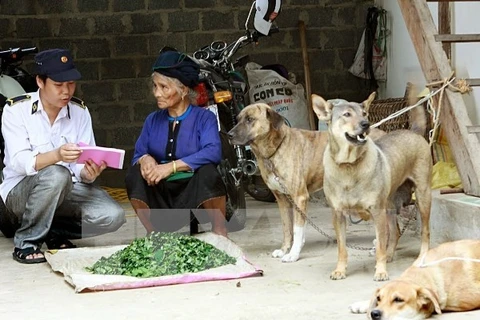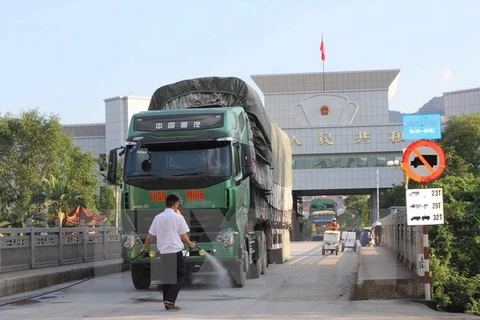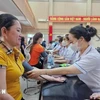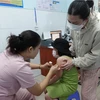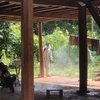Lao Cai (VNA) – The northern border provinces of Lao Cai and Lang Son have intensified measures to prevent A/H5N1, H5N6 and H7N9 avian influenza from entering Vietnam as the viruses are spreading in neighbouring China.
Lao Cai tightened cross-border poultry trading while staff of the agriculture, health and customs sectors as well as the border force have been mobilised to join the preventive work.
Tran Duc Hung, Deputy Director of the province’s Centre for International Health Quarantine, said relevant agencies have closely monitored people who enter or exit Vietnam from affected areas.
Display screens and posters were erected in border areas between the two countries, providing information related to avian influenza, thus raising public awareness of the danger and symptoms of the disease.
Chemicals were also sprayed in high-risk areas, vaccinations for poultry were distributed and smuggling and illegal poultry trading were cracked down on.
In Lang Son, regulations on quarantine and health examination were strictly conducted to early detect H7N9 suspected cases.
The province’s Centre for International Health Quarantine mobilised more personnel and installed body temperature monitoring equipment at border gates.
People who enter or exit Vietnam through the gates have been provided with advice on disease prevention measures.
Medicine and isolation wards have also been prepared at border gates in case of detecting persons with symptoms related to the influenza strains.
Statistics show that about 130,000 people entered Vietnam through border gates in Lang Son since the beginning of February.
Sharing a 253km land border with China, Lang Son has two international border gates (Huu Nghi and Dong Dang), two national border gates (Chi Ma and Binh Nghi), and several auxiliary ports of entry, through which thousands of people enter Vietnam every day, posing a high risk of disease transmission.
The World Health Organisation said the A/H7N9 virus is raging in 14 provinces and cities of China with a sharp rise in incidences and a high mortality rate (about 40 percent). From October 6, 2016, to February 19 this year, China recorded 425 people with A/H7N9, mostly in Yunnan and Guangxi provinces which border Vietnam.
In 2016, Vietnam recorded A/H5N1 outbreaks in poultry in seven communes and wards of six districts and townships in Nghe An province, Ca Mau province and Can Tho city. There haven’t been any A/H5N1 outbreaks in 2017, according to the Preventive Medicine Department under the Ministry of Health.
The flu viruses of A/H7N9 and A/H5N1 have yet to be reported in humans in Vietnam.-VNA
Lao Cai tightened cross-border poultry trading while staff of the agriculture, health and customs sectors as well as the border force have been mobilised to join the preventive work.
Tran Duc Hung, Deputy Director of the province’s Centre for International Health Quarantine, said relevant agencies have closely monitored people who enter or exit Vietnam from affected areas.
Display screens and posters were erected in border areas between the two countries, providing information related to avian influenza, thus raising public awareness of the danger and symptoms of the disease.
Chemicals were also sprayed in high-risk areas, vaccinations for poultry were distributed and smuggling and illegal poultry trading were cracked down on.
In Lang Son, regulations on quarantine and health examination were strictly conducted to early detect H7N9 suspected cases.
The province’s Centre for International Health Quarantine mobilised more personnel and installed body temperature monitoring equipment at border gates.
People who enter or exit Vietnam through the gates have been provided with advice on disease prevention measures.
Medicine and isolation wards have also been prepared at border gates in case of detecting persons with symptoms related to the influenza strains.
Statistics show that about 130,000 people entered Vietnam through border gates in Lang Son since the beginning of February.
Sharing a 253km land border with China, Lang Son has two international border gates (Huu Nghi and Dong Dang), two national border gates (Chi Ma and Binh Nghi), and several auxiliary ports of entry, through which thousands of people enter Vietnam every day, posing a high risk of disease transmission.
The World Health Organisation said the A/H7N9 virus is raging in 14 provinces and cities of China with a sharp rise in incidences and a high mortality rate (about 40 percent). From October 6, 2016, to February 19 this year, China recorded 425 people with A/H7N9, mostly in Yunnan and Guangxi provinces which border Vietnam.
In 2016, Vietnam recorded A/H5N1 outbreaks in poultry in seven communes and wards of six districts and townships in Nghe An province, Ca Mau province and Can Tho city. There haven’t been any A/H5N1 outbreaks in 2017, according to the Preventive Medicine Department under the Ministry of Health.
The flu viruses of A/H7N9 and A/H5N1 have yet to be reported in humans in Vietnam.-VNA
VNA



